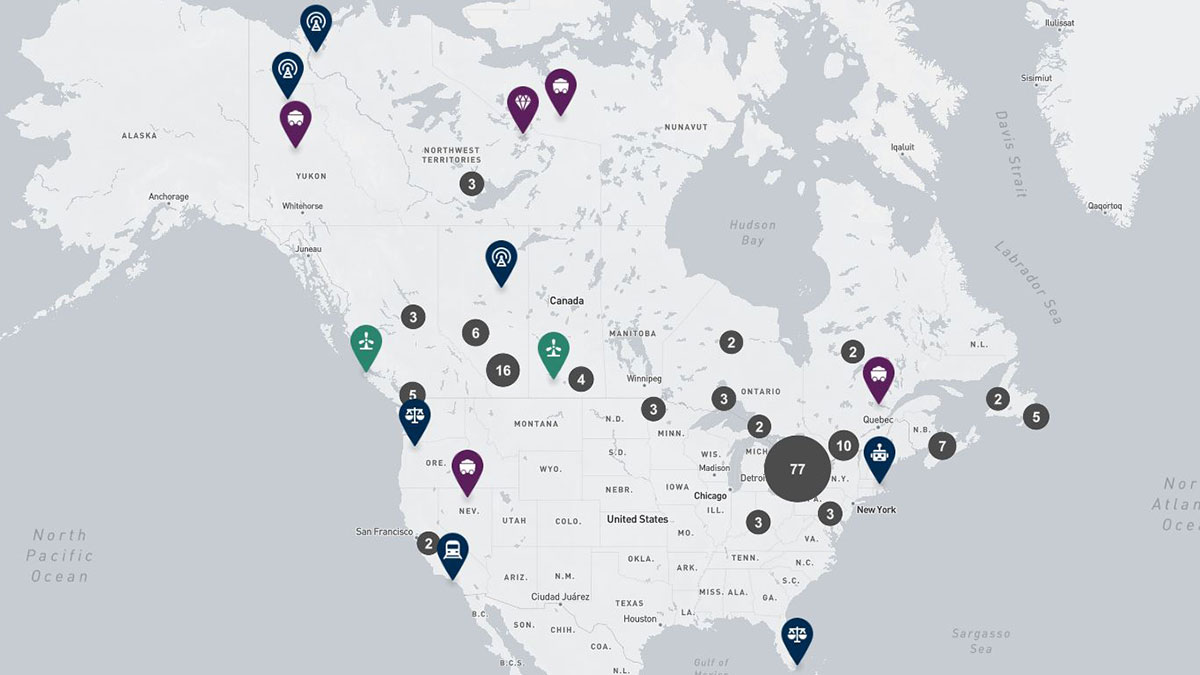Speaker
The environmental assessment process in Canada has changed—in scale, scope, scheduling, even in name. In this video, Dennis Mahony shares an insider’s perspective of the evolving world of environmental assessments and what proponents can expect.
In this video, Dennis discusses:
- how the new impact assessment regime differs from traditional environmental assessments
- why environmental assessments are so critical for the development lifecycle
- where political decision-making fits in the approvals process
- how approval authorities have widened their scope of inquiry
Click here to see other videos in this series.
Dennis Mahony (00:07): Hello, everybody. My name is Dennis Mahony, and I'm one of the Partners in our Projects Group. I'm also the Head of our Environmental Health and Safety Practice. Over the next few minutes, I'll be talking about environmental assessments in Canada, which is increasingly and more accurately being called impact assessment. If you're planning a major infrastructure project, there's a very good chance it will need an impact or environmental assessment approval—either federal or provincial, or both.
Dennis Mahony (00:39): What is an environmental or impact assessment and how has it changed in Canada over time? So first, at its most basic, an EA or environmental assessment is a planning tool. It's one that regulators use to identify and evaluate the impacts of a proposed land use—say a rail yard, a shipping port, a pipeline, a long highway—that evaluation begins with detailed studies done by experts, engineering teams, expert technical analysts. It continues through broad stakeholder consultation, Indigenous consultation in Canada is extremely important, and all that culminates ultimately in a determination by the approval authorities whether the project is ultimately acceptable.
Dennis Mahony (01:28): How is EA developed in Canada over the years? And when I say years, I really mean decades. So, first broad brush stroke is the "impacts" under the EA microscope have grown well beyond what most people think of as "environmental". The potential to harm air quality or wildlife or human health still remain very important, of course. But a modern EA is as much about social, cultural, heritage and economic impacts as it is about traditional environmental factors. Number two, big, broad brush strokes development is in a modern EA, the impacts are evaluated in light of a project's benefits. So there's more consideration of the positive impacts—more balancing—than there used to be. So as an example of how this plays out in practice, a standard feature of a modern federal impact assessment includes an evaluation of a local regional and national economic implications (the good and the bad) of a project. So who stands to gain economically and how, as well as who may not stand to gain economically, but maybe should is very much part of a modern EA evaluation. And so at the end of the exercise, the "yes/no" determination (the approval or not) is made based on exactly the kind of weighing of the public interest you would expect when such a broad range of factors are under consideration. So although the process is subject to a complicated legal framework, although there are many volumes of densely technical scientific reports, the government call or the judgment call at the end of the day is far more in the realm of political decision-making.
Dennis Mahony (03:23): Why is impact or environmental assessment so important for project developers? Two reasons, really. The first I alluded to already, which is the easiest one—most major infrastructure projects simply can't be built or operated in Canada without securing some form of EA or IA approval. Again, whether federal, provincial, or in a lot of cases, both. Second, and more nuanced, is because the modern process is such a broad-based balancing exercise, and because it's so public, it has become the forum of choice for project critics and opponents. So the process regularly attracts media attention. It's not uncommon to have public hearings—there's a lot of public consultation. And the government is there all through the process. It's a process in which the project must be exhaustively justified and defended. Every aspect gets put under a microscope, and for those reasons, an effective critic can have real influence. So that influence can be constructive and result in genuine improvements to the project. And really, that's the intent of the broad consultation. On the other end of the spectrum, that influence can crystallize into years of process delays, extensive and commercially-restrictive conditions for the project, or in the worst case, the end of the project altogether. So not an exercise to be taken lightly by any stretch. And experienced developers understand, in effect, they're climbing into a very consequential fishbowl.
Dennis Mahony (05:10): So I want to take you through a couple of examples from the federal EA fishbowl, and the first one is the $20 billion Teck oil sands project. Teck filed their EA with the federal government in their EA application in 2011, and they worked diligently on it for 9 years, this is an extremely intense process—regular consultation, report writing, questions being asked by federal authorities and more reports being written. And then in 2020, just as the federal cabinet was poised to make the ultimate "yes/no" decision on the project, Teck withdrew. That was national front page news, it sent a ripple effect through the country, through the EA community, and through the resource development community, especially out West. And the economic environment had changed during that time period. So that's one explanation. Another potential explanation was that Cabinet was going to say "no" for climate concerns. So a lot of speculation on why Teck withdrew, but I can tell you they focused very much in their public statements on how difficult the process was, and the process uncertainty. And so it is fair to say, that certainly for those in the Western resource community and elsewhere across Canada, Teck is now the poster child for the frustration potential of the federal EA process. My second example is—if it's not tied for first, it's a close second—and that's the $22 billion TMX pipeline. Very high-profile, it was front page news for years before Teck made it to the front page. And public consultation for that project, just by way of background, had started in 2012. The project literally had to be bought out by the federal government in 2018 to keep it alive amidst uncertainty over the approvals process. And so, the good news ultimately for the project developer—which is the federal government—is it got back on track and it's now scheduled for a 2023 completion. The not so good news from a process perspective is that it was a very bumpy ride and it will have, if it gets completed in 2023, have taken 11 years. That's a very long time in the business world. Now there are of course projects that get through in less time. The Contrecour Port Project, right in the middle of a major urban centre in Montréal, that took five years, and it was approved about this time last year. So five years isn't short but it certainly isn't the kind of ride that those other projects got.
Dennis Mahony (07:58): That was under the old regime, which is called CEAA 2012, and CEAA is the acronym for Canadian Environmental Assessment Act. That Act was replaced in 2019 with the aptly-named Impact Assessment Act, really updating to reflect the breadth of the process. Now there were a number of significant changes. Two important ones are that the factors for consideration have been updated and they're very broad as you might expect, and the applicable evaluative test has been reshaped. So at a very high level those changes and others notwithstanding, the regime follows the contours of its predecessor. So more familiar in the new IAA than there is brand new. So the new Act has attracted a lot of attention. Some, for example, calling it "the pipeline killer". Others have characterized it as a long overdue update to what was already happening in practice.
Dennis Mahony (09:03): So let's talk about three things we like about the new Act. First, there's a new "planning phase" and that mandates early engagement with stakeholders, early engagement—very importantly—with Indigenous Peoples, and detailed planning with the regulator for the assessment process to come. And that includes planning out the specific timelines that will apply when things are due, for example. So this kind of planning was done in practice, in a less formalistic way, by developers with Canadian EA experience, even under the old regime. They knew that early upfront work helped projects run more smoothly and that is now built into the system so it's mandatory and projects should, at least in theory, get an easier ride or at least identify stakeholders sticking points much earlier when there will be more flexibility for the project to adjust. So that's a "right out of the gate" process. Second, and this may be the most important of the three but in my view, often overlooked, is that the new Act takes process speed. And what I mean by that, is avoiding regulator-driven delays more seriously than the old Act. Under the old Act, there were mandatory statutory timelines for the regulator so the regulator had to carry out their task within certain time periods. But those were hampered by a mechanism that would "stop the clock", routinely. So that a process that looked on paper—or if you read the statute—like it would take 2 or 3 years, could in fact turn into a 7 to 10 year or more process. And remember, CEAA 2012 (the Canadian Environmental Assessment Act, 2012), was the one that saw Teck and its 9 years and the lengthy time period that TMX took.
Dennis Mahony (10:58): So just having statutory timelines on its own doesn't always do the trick. So the last one I want to mention is the express focus in the new Act on a project's beneficial impacts. In contrast to its predecessor's focus on adverse effects. So I don't want to give you the impression that the potential adverse effects are not considered, they of course remain front and centre, but there is now expressly in the new federal Act a requirement for decision makers to balance the positive. So the new Act recognizes what was an old practice of EA developers, making sure the decision makers understood that there was positive benefits. That's now part of our process, and that was a good development. So overall, do we think the new impact assessment regime fixes all the ills of the old regime? I would say of course not. Updates to statutes rarely get it perfect, but in our experience thus far, it's been easier and faster to navigate in practice. Again, assuming that the developer understands the right techniques and employs them.
Dennis Mahony (12:15): So the very latest development, almost hot off the presses, is a national newsworthy development comes from just last month, and it's a big one so on May 10th, the Alberta Court of Appeal concluded that the new Federal Impact Assessment Act is unconstitutional. And for those of you interested in constitutional law, it's a very interesting read, all 200 pages or so of it. And it will be going up to the Supreme Court of Canada, who will have the final word. So there'll be even more to read for those of us who like this area. So a couple of important points about the Alberta Court of Appeal’s opinion. First, its advisory. It is of the highest court in one province. And it carries a great deal of influence, as it should. But it does not invalidate the legislation, either in Alberta or elsewhere across the country. The Impact Assessment Act is still very much alive and kicking. Second, the opinion is squarely aimed at projects within provincial boundaries that don't have an inter-provincial or across-provincial boundaries element. So the court was not focused on national railways or inter-provincial pipelines, for example. Having said that, the Court concluded that the Act as a whole should fall. So if the Supreme Court were to make that same determination, the Impact Assessment Act would not be "alive and kicking" anymore. So those caveats in mind, I think it's a very well-written opinion. This is not a provincial judgment that gives the back of the hand to environmental protection. It articulates a legitimate tension between the scope of the new federal impact assessment regime and the provincial right to regulate local resource development. As I noted earlier, modern EA is much broader in scope than the casual observer would expect. And with that kind of breadth, tension with provincial legislation is inevitable. So ultimately, the Supreme Court will make the final call.
Dennis Mahony (14:21): I want to wrap up today with one piece of advice I always give to first-timers. Because the process is a very public test of just about every aspect of your project, and because spirited opposition is not uncommon, developers should assume—right from the outset—that the project will sooner or later be under a microscope in the courts. Most of them are. So that means that all those scientific studies and everything else about the project will eventually be picked apart by lawyers in an adversarial contest. So if that likelihood is top of mind from the day you first commence your project, so if you see that coming in advance, you will be able to incorporate that perspective into your planning, frankly, into everything you draft. So think of that big environmental report your team is drafting as Exhibit One in the court proceeding to come, because in our experience, there's a very good chance that will be the case. Thanks very much for watching today. For more on our projects work, please head to www.torys.com.
Get to know our Projects practice

Publication
Learn more about our team
See how our multidisciplinary Environmental team helps companies manage environmental nuances impacting operations, projects, transactions and disputes.

Mandat
See an example of our environmental work
Learn how we helped CN Rail build a major new rail facility in the Greater Toronto and Hamilton Area by navigating a complex, multi-year federal environmental approval process and high-profile public hearing, as well as several related court proceedings.
20 janv. 2021

Explore our work by type and region
Visit our new interactive Project Map to see a cross-section of projects we’ve advised on in Canada, the U.S., and beyond.
Inscrivez-vous pour recevoir les dernières nouvelles
Restez à l’affût des nouvelles d’intérêt, des commentaires, des mises à jour et des publications de Torys.
Inscrivez-vous maintenant
